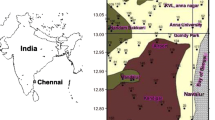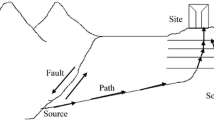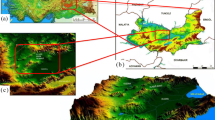Abstract
Due to the soft soil condition, it has been found that buildings in Bangkok locating 200 km away from epicentral of an earthquake can be damaged as a result of high ground motion (e.g. earthquakes of magnitudes 5.3–5.9 in 1983). Because of rapid urban expansion and population growth in cities with soft soil condition, such as Bangkok, the assessment of seismic vulnerability of building structures becomes necessary. The purpose of this study is to quantify variability and develop attenuation and amplification models of ground motions for Bangkok sites. First, by analysing soil profile of Bangkok using Latin Hypercube sampling technique, critical attenuation and amplification characteristics, such as peak ground acceleration, ground motion intensity, frequency content and significant ground duration, were obtained. Then, the statistical information on the attenuation and amplification models of these characteristics was established and used to conduct a series of non-linear seismic analysis of a typical four storey commercial building in Bangkok. The research outcomes demonstrate that the developed models are capable of predicting the damage indices of buildings in Bangkok under different earthquake intensities and epicentral distances.













Similar content being viewed by others
References
AIT (1981) Results of laboratory tests on subsoils of Bangkok and adjacent areas, vol 2. Asian Istitute of Technology, Thailand
Ang AHS, Tang WH (1975) Probability concepts in engineering planning and design, vol Volume I. Wiley, New York
Arango I, Dietrich RJ (1972) Soil and earthquake uncertainties on site response studies. Paper presented at the international conference on microzonation for safer construction, research and application
Charusiri P, Daorerk V, Muangnoichareon N, Lamjuan A, Kosuwan S (2004) Exploration of active fault in Kanchanaburi, Lampang and Phrae province project. Technical report, Department of Geology. Faculty of Science, Chulalongkorn University
Clough RW, Penzien J (1993) Dynamics of structures/Ray W. Clough, Joseph Penzien. McGraw-Hill, New York, c1993. 2nd ed
Dobry R, Idriss IM, Ng E (1978) Duration characteristics of horizontal components of strong-motion earthquake records. Bull Seismol Soc Am 68:1487–1520
Esteva L, Villaverde R (1973) Seismic risk, design spectra and structural reliability. Paper presented at the proceedings of the 5th world conference on earthquake engineering, Rome
Esteva L, Villaverde R (1977) Seismic risk, design spectra and structural reliability. Paper presented at the proceedings of the sixth world conference on earthquake engineering, New Delhi
Fenton CH, Charusiri P, Wood SH (2003) Recent paleoseismic investigations in northern and western Thailand. Ann Geophys 46:957–981
Frankel A (1995) Mapping seismic hazard in the Central and Eastern United States. Seismol Res Lett 66:8–21
Gutenberg B, Richter CF (1956) Earthquake magnitude, intensity, energy, and acceleration. Bull Seismol Soc Am 46:105–145
Hinthong C (1995) The study of active faults in Thailand. Paper presented at the proceedings of the annual technical 1995 conference on the progression and vision of mineral resources development
Hwan KS (1985) dynamic analysis of ground motion during earthquake in Bangkok. Unpublished Degree of Master of Engineering
Kosuwan S, Hinthong C, Charusiri P (1999) The preliminary use of MapInfo programme to earthquake hazard assessment in Thailand and mainland SE Asia. J Geol Ser B 13–14:174–178
Kuwamura H, Galambos TV (1989) Earthquake load for structural reliability. J Struct Eng 115:1446–1462. doi:10.1061/(ASCE)0733-9445(1989)115:6(1446)
Lai SSP (1982) Statistical characterisation of strong ground motions using poewr spectral density function. Bull Seismol Soc Am 72:259–274
McKay MD, Beckman RJ, Conover WJ (1979) A comparison of three methods for selecting values of input variables in the analysis of output from a computer code. The American Society for Quality Control and The American Statistical Association
Nutalaya P, Shrestha (1990) Earthquake ground motions and seismic risk in Thailand. Paper presented at the proceedings of the 1990 annual conference engineering Institute of Thailand, Bangkok
Ornthammarath T, Warnitchai P, Worakanchana K, Zaman S, Sigbjörnsson R, Lai CG (2011) Probabilistic seismic hazard assessment for Thailand. Bull Earthq Eng 9:367–394. doi:10.1007/s10518-010-9197-3
Palasri C (2006) Probabilistic seismic hazard map of Thailand. Chulalongkorn University, Thailand
Park YJ, Ang HS (1985) Seismic damage model for reinforced concrete. J Struct Eng, ASCE 111:722–739
Park YJ, Reinhorn AM, Kunnath SK (1987) Inelastic damage analysis of reinforced concrete frame shear wall structure. State University of New York, Buffalo
Petersen MD, Dewey J, Hartzell S, Mueller C, Harmsen S, Frankel AD, Rukstales K (2004) Probabilistic seismic hazard analysis for Sumatra, Indonesia and across the Southern Malaysian Peninsula. Tectonophysics 390:141–158. doi:10.1016/j.tecto.2004.03.026
Sadigh K, Chang CY, Egan JA, Makdisi F, Youngs RR (1997) Attenuation relationships for shallow crustal earthquakes based on California strong motion data. Seismol Res Lett 68:180–189
Samuthsakorn S (1983) Earthquake in Kanjanaburi. Meteorological Department of Thailand, Bangkok
Schnabel PB, Lysmer J, Seed HB (1972) SHAKE: a computer program for earthquake response analysis of horizontally layered sites. University of California, Earthquake Engineering Research Center, Berkeley
Seed HB, Idriss IM (1969) Characteristic of rock motions during earthquake. J Soil Mech Found Division 95:1199–1218
Seed HB, Idriss IM (1970) Soil moduli and damping factors for dynamic response analysis. University of California, Earthquake Engineering Research Centre, Berkeley
Seed HB, Murarka R, Lysmer J, Idriss IM (1976) Relationships of maximum acceleration, maximum velocity, distance from source, and local site conditions for moderately strong earthquakes. Bull Seismol Soc Am 66:1323–1342
Tso WK, Zhu TJ, Heidebrecht AC (1992) Engineering implication of ground motion A/V ratio. Soil Dyn Earthq Eng 11:133–144. doi:10.1016/0267-7261(92)90027-B
Vanmarcke EH, Lai SSP (1980) Strong-motion duration and RMS amplitude of earthquake records. Bull Seismol Soc Am 70:1293–1307
Warnitchai P, Lisantono A (1996) Probabilistic seismic risk mapping for Thailand. Paper presented at the 11th world conference on earthquake engineering, Acapulco, June 23–28
Author information
Authors and Affiliations
Corresponding author
Rights and permissions
About this article
Cite this article
Herath, N., Mendis, P. & Zhang, L. A probabilistic study of ground motion simulation for Bangkok soil. Bull Earthquake Eng 15, 1925–1943 (2017). https://doi.org/10.1007/s10518-016-0058-6
Received:
Accepted:
Published:
Issue Date:
DOI: https://doi.org/10.1007/s10518-016-0058-6




